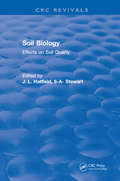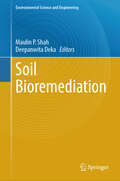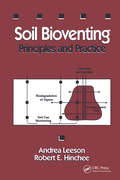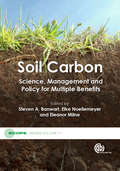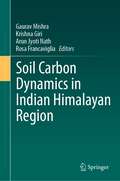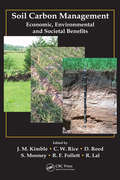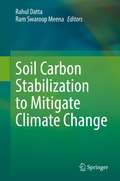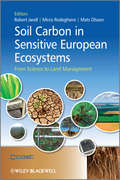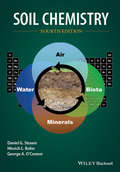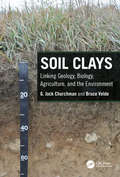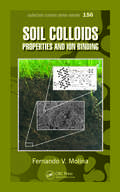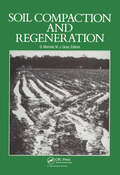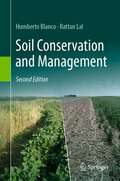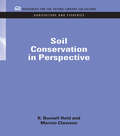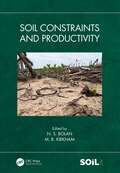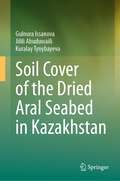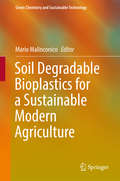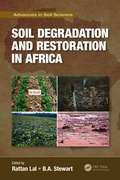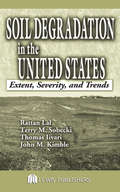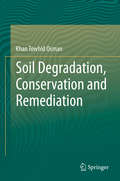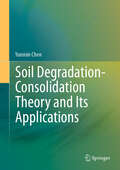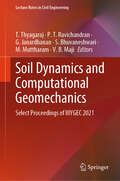- Table View
- List View
Soil Biology: Effects on Soil Quality (Advances In Soil Science Ser.)
by J. L. HatfieldSoil Biology is a state-of-the art review focusing on the linkage between biological processes that occur in the soil and their impact on soil quality. Topics considered include the microbial ecology of conservation management systems, dynamic processes of vesicular-arbuscular mycorrhizae, earthworms and soil fauna, microbial processes in the soil, and the degradation of pesticides through microbial processes. The book will interest soil scientists, microbiologists, agronomists, and soil ecologists.
Soil Bioremediation (Environmental Science and Engineering)
by Maulin P. Shah Deepanwita DekaThis book is presented on bioremediation of soil including different aspects for sustainable development of agriculture, environment etc. Significant attention is being paid to plants and microbes because of their metabolomics, molecular mechanisms, biochemical pathways, bioengineering, and cost-effective nature in an eco-friendly green approach. It presents a detailed account on phytoremediation, microbial remediation; application of different plants and microorganisms for bioremediation in agricultural soil; nanoparticles, metabolites produced by plants and microbes for bioremediation of soil; multidisciplinary approaches of bioremediation to alleviate major soil contamination issues, molecular mechanisms, biochemical approach of bioremediation of soil; plants and microbial engineering for bioremediation; recent advances and challenges; future prospects of bioremediation of contaminated soil, utilizing biodiversity for sustainable development of the soil ecosystem.
Soil Bioventing: Principles and Practice
by Andrea Leeson Robert E. HincheeSoil bioventing is one of the most popular modern techniques for removing contaminants from soil. It has recently emerged as one of the most cost-effective and efficient technologies available for vadose zone remediation of petroleum-contaminated sites. This book explains in practical terms how to carry out a bioventing program. It is an interdisciplinary treatment of the subject, covering everything from basic physical and chemical properties of soils to site evaluation, project design, and post-bioventing monitoring.The wide breadth of coverage makes Soil Bioventing useful to a large audience, including consulting firms, students, contractors, environmental managers, and anyone who is responsible for supervision of soil cleanup for regulatory reasons.
Soil Carbon
by Meine Van Noordwijk Pete Smith Christiano Ballabio Daniel Buschiazzo Elke Noellemeyer Steven A Banwart Bas Van Wesemael Genxing Pan Francesca Bampa Rich Conant Heitor L.C. Coutinho Patrick Gicheru Andre Bationo Roger Funk David Werner Martial Bernoux Unai Pascual Tapas Bhattacharyya Marty Goldhaber Hans Joosten Dave Abson Niels Batjes Carlos Eduardo Cerri Generose Nziguheba David Powlson Christian Feller Pierre-Alain Maron Luca Montanarella Yongcun Zhao Chris Duffy Eleanor MilneThis book brings together the essential evidence and policy opportunities regarding the global importance of soil carbon for sustaining Earth's life support system for humanity. Covering the science and policy background for this important natural resource, it describes land management options that improve soil carbon status and therefore increase the benefits that humans derive from the environment. Written by renowned global experts, it is the principal output from a SCOPE rapid assessment process project. Read a chapter for free
Soil Carbon Dynamics in Indian Himalayan Region
by Rosa Francaviglia Arun Jyoti Nath Gaurav Mishra Krishna GiriThe contributed volume assimilates the knowledge, experience, and exciting aspects of soil carbon research in the Indian Himalayan region. It includes different aspects and factors associated with soil carbon sequestration in the region, one of the biodiversity hot spots and highly vulnerable to climatic change impacts. Information on different aspects of soil organic carbon dynamics concerning adaptive land management practices and anthropogenic impacts is covered. Further topics include applying advanced tools and techniques to soil carbon vis-a-vis soil erosion research. This book is of interest to researchers and policymakers involved in soil carbon research and offer ideas to enhance the soil carbon in the region concerned. In addition, the book will provide up-to-date information for researchers interested in soil carbon research for the maintenance of soil quality and fertility in the climate-vulnerable Indian Himalayan region.
Soil Carbon Management: Economic, Environmental and Societal Benefits
by R. Lal J. M. Kimble C. W. Rice D. Reed S. Mooney R. F. FollettBetter Manage Soil C for Improved Soil Quality In the United States, soil has fueled the availability of abundant, safe food, thus underpinning economic growth and development. In the future we need to be more vigilant in managing and renewing this precious resource by replacing the nutrients and life-sustaining matter that we remove for
Soil Carbon Stabilization to Mitigate Climate Change
by Ram Swaroop Meena Rahul DattaCarbon stabilization involves to capturing carbon from the atmosphere and fix it in the forms soil organic carbon stock for a long period of time, it will be present to escape as a greenhouse gas in the form of carbon dioxide. Soil carbon storage is an important ecosystem service, resulting from interactions of several ecological processes. This process is primarily mediated by plants through photosynthesis, with carbon stored in the form of soil organic carbon. Soil carbon levels have reduced over decades of conversion of pristine ecosystems into agriculture landscape, which now offers the opportunity to store carbon from air into the soil. Carbon stabilization into the agricultural soils is a novel approach of research and offers promising reduction in the atmospheric carbon dioxide levels. This book brings together all aspects of soil carbon sequestration and stabilization, with a special focus on diversity of microorganisms and management practices of soil in agricultural systems. It discusses the role of ecosystem functioning, recent and future prospects, soil microbial ecological studies, rhizosphere microflora, and organic matter in soil carbon stabilization. It also explores carbon transformation in soil, biological management and its genetics, microbial transformation of soil carbon, plant growth promoting rhizobacteria (PGPRs), and their role in sustainable agriculture. The book offers a spectrum of ideas of new technological inventions and fundamentals of soil sustainability. It will be suitable for teachers, researchers, and policymakers, undergraduate and graduate students of soil science, soil microbiology, agronomy, ecology, and environmental sciences
Soil Carbon in Sensitive European Ecosystems
by Mats Olsson Robert Jandl Mirco RodeghieroSoil Carbon in Sensitive European Ecosystems - From Science to Land Management is a comprehensive overview of the latest research in this field drawn together by a network of scientists from across Europe. Soil carbon assessments are crucial at present to our understanding of the dynamics of terrestrial ecosystems and our ability to assess implications for the global carbon exchange and its consequences on the future climate. This book focuses primarily on ecosystems and their soil carbon stocks. The book identifies three key sensitive ecosystems within Europe: Mediterranean Forest and Agricultural Systems; Mountains; and Peatland.Contributors include those currently working for the European research programme, COST Action 639 BurnOut (www.cost639.net; 2006-2010).COST Action 639 emerged from a demand from policy makers in Europe for more detailed information on soil carbon dynamics. The cooperation between experts for reporting and experts for soil dynamics is the focus of the book. This book seeks to provide an up-to-date account on the state-of-the-art research within this topical field.
Soil Carbon: Science, Management and Policy for Multiple Benefits
by Meine Van Noordwijk Pete Smith Christiano Ballabio Daniel Buschiazzo Bas Van Wesemael Genxing Pan Francesca Bampa Rich Conant Heitor L.C. Coutinho Patrick Gicheru Andre Bationo Roger Funk David Werner Martial Bernoux Unai Pascual Tapas Bhattacharyya Marty Goldhaber Hans Joosten Dave Abson Niels Batjes Carlos Eduardo Cerri Generose Nziguheba David Powlson Christian Feller Pierre-Alain Maron Luca Montanarella Yongcun Zhao Chris DuffyThis book brings together the essential evidence and policy opportunities regarding the global importance of soil carbon for sustaining Earth's life support system for humanity. Covering the science and policy background for this important natural resource, it describes land management options that improve soil carbon status and therefore increase the benefits that humans derive from the environment. Written by renowned global experts, it is the principal output from a SCOPE rapid assessment process project.
Soil Chemistry
by Daniel G. Strawn Hinrich L. Bohn George A. O'ConnorSoil is key to sustaining life—affecting air and water quality, the growth of plants and crops, and the health of the entire planet. Soil Chemistry 4e provides comprehensive coverage of the chemical interactions among organic and inorganic solids, air, water, microorganisms, and the plant roots in soil. The fourth edition of Soil Chemistry has been revised and updated throughout and provides a basic description of important research and fundamental knowledge in the field. The text covers chemical processes that occur in soils, including: distribution and species of nutrients and contaminants in soils; aqueous chemistry of soil solutions and mineral dissolution; oxidation and reduction reactions in soils; soil mineral formation processes and properties; the formation and reactivity of soil organic matter; surface chemistry and cation, anion, and organic compound adsorption reactions; modelling soil chemical reactions; and reactions in acid and salt affected soils. Although extensively revised with updated figures and tables, the fourth edition maintains the focus on introductory soil chemistry that has distinguished earlier editions. New chapters on properties of elements relevant to soil chemistry, and a chapter with special focus on soil surface characteristics have been added. Special Topics boxes are also included in the Fourth Edition that includes examples, noteworthy topics, and case studies. End of chapter questions are included as a resource for teaching.
Soil Chemistry
by Daniel G. Strawn Hinrich L. Bohn George A. O'ConnorProvides comprehensive coverage of the chemical interactions among organic and inorganic solids, air, water, microorganisms, and the plant roots in soil This book focuses on the species and reaction processes of chemicals in soils, with applications to environmental and agricultural issues. Topics range from discussion of fundamental chemical processes to review of properties and reactions of chemicals in the environment. This new edition contains more examples, more illustrations, more details of calculations, and reorganized material within the chapters, including nearly 100 new equations and 51 new figures. Each section also ends with an important concepts overview as well as new questions for readers to answer. Starting with an introduction to the subject, Soil Chemistry, 5th Edition offers in-depth coverage of properties of elements and molecules; characteristics of chemicals in soils; soil water chemistry; redox reactions in soils; mineralogy and weathering processes in soils; and chemistry of soil clays. The book also provides chapters that examine production and chemistry of soil organic matter; surface properties of soil colloids; adsorption processes in soils; measuring and predicting sorption processes in soils; soil acidity; and salt-affected soils. Provides a basic description of important research and fundamental knowledge in the field of soil chemistry Contains more than 200 references provided in figure and table captions and at the end of the chapters Extensively revised with updated figures and tables Soil Chemistry, 5th Edition is an excellent text for senior-level soil chemistry students.
Soil Classification: A Global Desk Reference
by Hari Eswaran B. A. Stewart Robert Ahrens Thomas J. RiceDevelopments in soil classification have accompanied parallel progress in our understanding of the soil system. However the theories behind the classifications and the purposes for which they were created have changed over time. The editors hope that this comprehensive synthesis will help to rally soil scientists around the world to develop an acce
Soil Clays: Linking Geology, Biology, Agriculture, and the Environment
by G. Jock Churchman Bruce VeldeAs the human population grows from seven billion toward an inevitable nine or 10 billion, the demands on the limited supply of soils will grow and intensify. Soils are essential for the sustenance of almost all plants and animals, including humans, but soils are virtually infinitely variable. Clays are the most reactive and interactive inorganic compounds in soils. Clays in soils often differ from pure clay minerals of geological origin. They provide a template for most of the reactive organic matter in soils. They directly affect plant nutrients, soil temperature and pH, aggregate sizes and strength, porosity and water-holding capacities. This book aims to help improve predictions of important properties of soils through a modern understanding of their highly reactive clay minerals as they are formed and occur in soils worldwide. It examines how clays occur in soils and the role of soil clays in disparate applications including plant nutrition, soil structure, and water-holding capacity, soil quality, soil shrinkage and swelling, carbon sequestration, pollution control and remediation, medicine, forensic investigation, and deciphering human and environmental histories. Features: Provides information on the conditions that lead to the formation of clay minerals in soils Distinguishes soil clays and types of clay minerals Describes clay mineral structures and their origins Describes occurrences and associations of clays in soil Details roles of clays in applications of soils Heavily illustrated with photos, diagrams, and electron micrographs Includes user-friendly description of a new method of identification To know soil clays is to enable their use toward achieving improvements in the management of soils for enhancing their performance in one or more of their three main functions of enabling plant growth, regulating water flow to plants, and buffering environmental changes. This book provides an easily-read and extensively-illustrated description of the nature, formation, identification, occurrence and associations, measurement, reactivities, and applications of clays in soils.
Soil Colloids: Properties and Ion Binding (Surfactant Science)
by Fernando V. MolinaWithin the field of soil science, soil chemistry encompasses the different chemical processes that take place, including mineral weathering, humification of organic plant residues, and ionic reactions involving natural and foreign metal ions that play significant roles in soil. Chemical reactions occur both in the soil solution and at the soil part
Soil Compaction and Regeneration: Proceedings of the workshop on 'soil compaction:consequences, structural regeneration processes', Avignon, France, 17-18 September 1985
by G.MONNIER; M.J.GOSSA collection of conference Proceedings of the Workshop on 'Soil Compaction: Consequences, Structural Regeneration Processes', Avignon, France, 17-18 September 1985.
Soil Conservation and Management
by Rattan Lal Humberto BlancoThis updated and expanded second edition textbook, describes all main aspects of soil management, to address the serious problems of soil erosion and the attendant environmental pollution. The global high demands for food, fiber, feed, and fuel put a constant strain on the environment, which can only be mitigated by soil conservation. This edition incorporates new concepts and provides an up-to-date review of soil management principles and practices. The authors also added new chapters on cover crops, crop residues, soil water management, nutrient management, perennials in crop rotations and organic amendments. All practices have a clear perspective on addressing soil erosion, physical and chemical problems, carbon dynamics and sequestration as well as non-point source pollution. The restorative nature of many practices, also consider water conservation as a main pillar of sustaining a healthy soil. This textbook is valuable for students and professionals in soil science, agronomy, agricultural engineering, hydrology, and management of natural resources.
Soil Conservation in Perspective (RFF Agriculture and Fisheries Set)
by Marion Clawson R. Burnell HeldThis book reviews and evaluates the nationwide soil conservation effort in the United States and suggests broad outlines of a future conservation program. Originally published in 1965
Soil Constraints and Productivity
by N. S. Bolan M. B. KirkhamIdentifying, interpreting, and managing soil constraints are major challenges, especially when multiple constraints occur in the same soil at various depth zones. Although amelioration tools and strategies are available to manage some of these constraints, field adoption of these technologies is a major challenge to the farming community. Soil Constraints and Productivity helps in identifying and understanding soil constraints, focusing on management practices to alleviate problems associated with these restrictions, and their impacts on crop productivity. Soil Constraints and Productivity aims to: Describe various strategies suitable for mitigating soil constraints Provide data on cost-benefit analysis of managing soil constraints Provide case studies of managing soil constraints to increase productivity Soil is essential for the doubling of major grain production proposed to be necessary to avoid major food security collapses in the future. This book will be a key resource for soil and environmental scientists, farmers, students majoring in agricultural and environmental sciences, and crop consultants.
Soil Cover of the Dried Aral Seabed in Kazakhstan
by Gulnura Issanova Jilili Abuduwaili Kuralay TynybayevaThis book summarizes the outcomes of research results based on field works and recent studies related to soil cover of the dried Aral seabed in Kazakhstan. The purpose of the work was to conduct a comprehensive assessment of the current state of the soil cover in the dried bed of the Aral Sea in order to study the processes that are occurring in the local soils as a result of anthropogenic impacts inducing soil degradation and desertification (e.g., soil salinization and deflation). Additionally, the book analyzes morphological characteristics and chemical-physical properties of soils in the dried bottom of the Northern Aral Sea in order to know how material properties can be transported during soil deflation in dust/sand/salt storms in the region, as well as to identify changes in long-term dynamics of aridization and climatic parameters such as temperature, precipitation and evapotranspiration in the Aral Sea region.The novelty of this research is reflected in the latest information on the vertical and spatial distributions of soils and their chemical properties in the region containing the dried bed of the Aral Sea in Kazakhstan. Consequently, an updated soil map (soil salinization and salinization degree, land degradation) of the seabed was obtained according to the collected field data and satellite-derived images such as those recorded by Landsat-8. The book is mainly addressed to scientists and researchers who study soil cover in the dried Aral Seabed and its region, as well as soil degradation and desertification in the dried lake playas and aridization in other arid regions. The book will also be useful for students and planners who feel responsible for the sustainable development and sustainable use of natural resources in Central Asian countries.
Soil Degradable Bioplastics for a Sustainable Modern Agriculture
by Mario MalinconicoThis book shows how the use of biodegradable plastics in agriculture can have a profound positive impact on plasticulture. Starting with an organic chemistry approach to biodegradable and compostable plastics, both natural and synthetic, it then analyzes the technological and agronomic aspects of existing bioplastics for protected cultivation (mulching, direct cover, low tunnels). It describes the new sprayable biodegradable mulching method, which is based on the use of waterborne polysaccharides and cellulosic fibers. A further chapter describes the research and technology of biodegradable plastics for different agricultural practices. It also includes chapters on life cycle assessment (LCA) of biodegradable plastics for agriculture, and existing and developing standards in the field. It is a valuable resource for agronomists, chemical and materials engineers, polymer technologists and scientists, as well as for a more general readership interested in the application of green chemistry principles to the vast world of crop production. Mario Malinconico
Soil Degradation and Restoration in Africa (Advances in Soil Science)
by Rattan Lal B. A. StewartSoil degradation is a widespread problem in Africa resulting in low agricultural productivity while demand for food continues to increase. Degradation is caused by accelerated erosion, acidification, contamination, depletion of soil organic matter and plant nutrients, and salinization. Food and nutritional security of the growing population of Africa can only be achieved if degraded soils are restored, and soils of agroecosystems are managed prudently and sustainably. This book describes the soils of Africa, processes of soil degradation, extent and severity of soil degradation, and the impacts of degradation processes on food and nutritional security.
Soil Degradation in the United States: Extent, Severity, and Trends
by Rattan Lal John M. Kimble Thomas IivariSoil Degradation in the United States: Extent, Severity, and Trends examines the magnitude and severity of soil degradation by different processes in the U.S., including water erosion, wind erosion, C depletion, soil compaction, salt build-up, and soil contamination. In addition, it addresses policy issues with regard to economic and environmental
Soil Degradation, Conservation and Remediation
by Khan Towhid OsmanIn view of the grave consequences of soil degradation on ecosystem functions, food security, biodiversity and human health, this book covers the extent, causes, processes and impacts of global soil degradation, and processes for improvement of degraded soils. Soil conservation measures, including soil amendments, decompaction, mulching, cover cropping, crop rotation, green manuring, contour farming, strip cropping, alley cropping, surface roughening, windbreaks, terracing, sloping agricultural land technology (SALT), dune stabilization, etc. , are discussed. Particular emphasis is given to soil pollution and the methods of physical, chemical and biological remediation of polluted soils. This book will lead the reader from the basics to a comprehensive understanding of soil degradation, conservation and remediation.
Soil Degradation-Consolidation Theory and Its Applications
by Yunmin ChenThis book focuses on skeleton-degradable soils, including three typical degradation processes of soil skeletons: soil particle breakage, chemical degradation, and biochemical degradation. Corresponding degradation models and constitutive models are proposed, and a degradation–consolidation theory is established. The theory overcomes the limitations of classical soil mechanics, such as the constant solid-phase mass assumption, and addresses the neglect of the effects of consolidation on degradation in environmental engineering. The theory provides key theoretical foundations and new analytical perspectives for understanding phenomena such as the degradation–consolidation processes in municipal solid waste landfills, the decomposition and exploitation of natural gas hydrates, and the behavior evolution of geomaterials under the influence of particle breakage. This book offers detailed theoretical insights, rich experimental data, and advanced numerical and physical simulation methods, particularly in environmental hazards prevention and control in municipal solid waste landfills. Hence, it is suitable for researchers, practitioners, and graduate students engaged in soil constitutive relations, multi-field coupling problems, and related fields.
Soil Dynamics and Computational Geomechanics: Select Proceedings of 8IYGEC 2021 (Lecture Notes in Civil Engineering #428)
by V. B. Maji M. Muttharam T. Thyagaraj P. T. Ravichandran G. Janardhanan S. BhuvaneshwariThis book presents the select proceedings of the 8th Indian Young Geotechnical Engineers Conference (8IYGEC 2021) on the following conference themes: soil dynamics and earthquake engineering, computational geomechanics and reliability in geotechnical engineering. The book covers a wide range of topics on liquefaction and stability analysis, dynamic properties, soil–structure interaction, response of framed structure on geotechnical seismic isolation system, seismic response of retaining walls with sand-tire chip mixtures, ground response analysis, probabilistic seismic hazard analysis, etc. The book can be a valuable reference for researchers and professionals.
